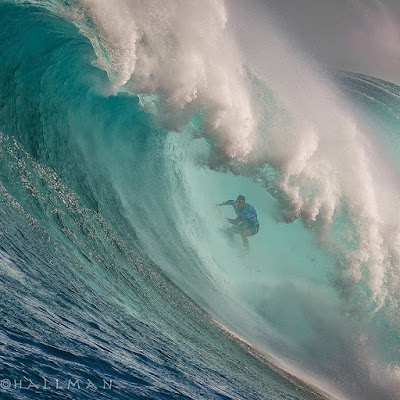Today it's the day of the Peahi Challenge. Here's the link to the WSL live webcast page. Photo by Richard Hallman.
Good luck to all the competitors with a special mention to Joao De Macedo, a fine Portuguese man I had the pleasure to meet at the shop yesterday. He qualified for the contest at Nazare (so he's used to big waves), but he arrived two days ago, first time in Maui, and today is going to be the first time he surfs Jaws. That is a massive handicap compared to the local guys that surfed it tens of times.
"I don't care, I'll be just stoked to be out there!", he said.
"And when a big one comes you'll put your head down and paddle as hard as you can", I replied.
"Exactly!"
Good luck Joao. At that size, it won't be an easy introduction to Jaws (if there is such a thing).

4am significant buoy readings
South shore
No indication of southerly energy at the outer buoys, the Surfline forecasts calls for 1.9f 12s.
North shore
NW
10.1ft @ 21s from 346° (NNW)
Hanalei
5.4ft @ 22s from 329° (NW)
Waimea
5.9ft @ 10s from 339° (NNW)
2.5ft @ 20s from 304° (WNW)
2ft @ 16s from 293° (WNW)
You don't see 10f 20s often and if you get excited when you see it, you're just as weird as me.
Hanalei is up to 5.4f 22s, so the energy is definitely coming down the islands chain, while Waimea still has to feel the very long period stuff. I wonder if the mix of periods (specially the 6f 10s one) still in the water will bother the shape of the waves at Jaws, my guess is that it won't. Places like that are a natural high period pass filters.
Below is a snapshot from yesterday evening at 6pm. On the left is the readings and graphs of the NW001 buoy as proposed by the Surfline buoy page (link n.11). On the right is what you get from the NOAA page, from which you wouldn't have any idea of the fact that there is 23s energy in the water.
The reason is that Surfline breaks down the overall energy in all the different swells hitting the buoy at that moment, the NOAA only reports the significant (which is very non significant for our purposes) wave height, defined as:
| the average of the highest one-third of all of the wave heights during the 20-minute sampling period. |

Let's now discuss when the swell going to peak in Maui. Below is the Surfline forecast for the Maui north shore (link n.15). I wrote down the information you would have if you go to that page and hover with the mouse over the arrows.
If you don't know what those couple of numbers mean, I strongly recommend you to attend the meteorology workshop I'm thinking about setting up. Please leave a comment if you might be interested, that'll motivate me to start preparing it, instead of surfing my ass off all day every day.
Now, that is a graph that has the size of the offshore swell on the Y axis. The size of the breaking waves will greatly vary from spot to spot, depending on the exposure to that direction (which for this swell is predicted to be around 325) and on the bottom of the ocean in front of the spot.
I personally don't know for sure when the peak of the swell will be at Jaws. I do know that the underwater canyon amplifies the longer periods more than the shorter ones, so we can assume that 10f 20s will make bigger waves than 11.6f 16s, so the peak should happen right after sunset.

Unless you're in the contest, finding a spot to surf on the north shore will be challenging as it will be a massive close out at one point during the day. Early morning will still be doable, after that look for sheltered places. Honolua Bay will be majestic, with the only variable caused by the fact that the wind will not be the usual offshore trades.
Wind map at noon shows very light sea northerly winds.

North Pacific shows a distant NW fetch and a closer N one.

South Pacific shows a small fetch.

Morning sky.










2 comments:
I would be interested in a meteorology workshop. While you're at it, throw in some material on tides and how they affect things. Mahalo!
thanks for the feedback!
Post a Comment